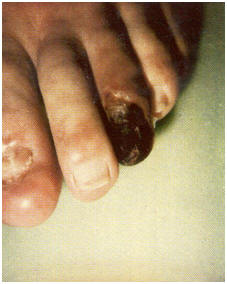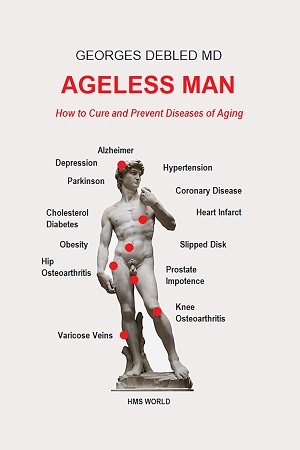ARTERIOSCLEROSIS, ATHEROSCLEROSIS AND
HYPERTENSION
How to understand
your disease of aging : ageless man
AGELESS MAN
AMAZON 2017-2022
According to the
"Vital Statistics Report" of the National Centre
for Health Statistics, the cardiovascular
diseases are the first cause of death in the
world and in the United States (30).
The arteries are
involved by two different phenomenon,
arteriosclerosis and atherosclerosis, which
occur often simultaneously.
The pathology of
arteriosclerosis is characterized by the
replacement of the muscular fibers of the artery
by collagen tissue which is inelastic.
A similar pathology was described 50 years ago
with the ureter under pressure.
The pathology of
atherosclerosis is characterized by fat and
cholesterol involvement of the arterial wall.
This phenomenon is the consequence of
cholesterol and lipid accumulation in the body
through the impaired sugar and fat metabolism
when testosterone is missing.
Arteriosclerosis and
atherosclerosis are two general involution
phenomenon increasing with the decrease of
testosterone secretion. It is probably the
reason for the elevation of blood pressure with
age
GANGRENE
GANGRENE
Gangrene of toes is
sometimes the result of maturity onset diabetes.
Testosterone treatment proposed by Jens
Moeller (6) gives spectacular results.


A B
A
. Man
aged 55, with gangrene of the left 1st and 3rd
toes for which amputation of the left leg had
been advised. (6)
B.
The left foot before (A) and after 3 months of
treatment with testosterone (6)
HYPER COAGULATION, VARIX, HEMORROIDES,
THROMBOSIS, ANEMIA,
BLOOD
HYPERCOAGULABILITY
The main question
about blood is not " how it coagulates" but "how
it remains fluid". Thrombosis and embolism are
common complications of cardiovascular diseases
usually treated by
anticoagulant agents as heparin or dicoumarin.
The use of those substances can produce
hemorrhages.
The dissolution of
the blood
clot is under the influence of fibrinolysis
agents.
Fibrinolitic agents
of the blood are under the influence of
testosterone as reported in the Lancet of the 21
July 1962 by Fearnley and coll. (2).
Claire Bonithon-Kopp
and coll. from the Broussais hospital in Paris,
who demonstrated in 1988 that low plasmatic
levels of male hormone contributes to
hypercoagulability and to ischemic heart disease
(3).
BLOOD FLUIDITY
Blood fluidity depends on antithrombin III which
is a blood fluidizing factor that allows blood
to flow. A normal amount of antithrombin III in
plasma ensures optimal fluidity which depends on
the available testosterone.
VARIX,
HEMORROIDS AND THROMBOSIS
Veins like arteries
are constituted by muscular fibres. Loss of
testosterone produces always an involution of
their muscular tissue.
ANEMIA
The number of red
blood cells is
decreased from
10% in castrated men. This is often so in men
with low testosterone plasmatic levels. The
ischemic heart disease is of course aggravated
by this phenomenon.
In 1981, Najean and coll. reported in the
American Journal of Medicine the improvement of
anemia in a serial of 137 patients when treated
by male hormones. Anemia recurs when the therapy
is stopped and improve again with androgens (4).
On the other hand,
patients with polyglobulia may constitute a
problem for therapy with androgens. The normal
account of red blood cells varies normally (5,4
+ 0,9 millions/milliliter) (5).
So patients with 6,3 millions red blood
cells/milliliter and presenting a failure in the
life maintenance system can be carefully treated
with an appropriate monitoring of the androgens
without increasing of the number of their red
blood cells. Those cases are rare.
Bibliography
1.
NATIONAL CENTER FOR HEALTH STATISTICS .Vital Statistics Report, Final Mortality
Statistics, 1982.
2.
FEARNEY G.R. AND CHAKRABARTI R. Increase of Blood Fibrinolytic Activity by
Testosterone :
The
Lancet, July 21 : 128-132, 1962.
3.
BONITHON-KOPP C., SCARABIN P.-Y., BARA L., CASTANIER M., JAQUESON A. AND ROGER
M. Relationship between Sex Hormones and Haemostatic Factors in Healthy
Middle-Aged Men : Artheriosclerosis, 71: 71-76, 1988.
4.
NAJEAN Y. and coll. Long Term Follow-up in Patients with Aplastic Anemia. A
study of 137 Androgen-Treated Patients Surviving more than Two Years :
Am. J. Med., 71 : 543-551, 1981.
5. HARRISON T.R. Principes de Médecine Interne. :
Appendice A 10. Tableau A-XII. Médecine-Sciences Flammarion, 1989.
Paris.
6.
MOELLER J. Cholesterol : 27
Springer-Verlag
Berlin
Heidelberg
New York
London
Paris
Tokyo 1987.
